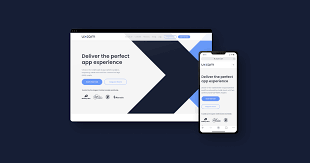User experience (UX) has always been a critical factor in the success of mobile apps development in India, but as the digital landscape evolves, so do user expectations. By 2025, the stakes will be higher than ever, and providing a seamless, intuitive, and enjoyable experience will be the key to standing out in a competitive app market.
In this guide, we’ll explore actionable strategies to optimize your mobile app for UX in 2025. By focusing on user-centered design, performance, personalization, and accessibility, you can create an app that not only meets but exceeds user expectations.
- Prioritize Speed and Performance
In 2025, users expect apps to be fast and responsive. Slow load times or laggy interactions can drive users away and harm your app’s reputation.
- Optimize Load Time: Reduce the size of images, scripts, and other resources. Use lazy loading techniques to only load content as needed, saving bandwidth and improving speed.
- Smooth Navigation: Minimize delays during navigation by optimizing transitions, animations, and gestures. Keep animations lightweight and responsive.
- Memory Management: Efficient memory usage is key. Avoid memory leaks and unnecessary background processes that can slow down performance.
Apps that load quickly and respond instantly not only keep users engaged but also contribute to a more enjoyable experience.
- Simplify and Streamline Navigation
Cluttered or complicated navigation can confuse users and lead to frustration. A simple, intuitive navigation system is essential for a positive UX.
- Minimalist Design: Use a clean, minimalist design that avoids overwhelming users with too many options. Prioritize key features and organize them logically.
- Clear Menu Structure: Ensure your menu is easy to find and navigate. Use recognizable icons and labels that communicate their function clearly.
- One-Handed Navigation: In 2025, smartphones will continue to be large, and one-handed operation will be crucial. Make sure your app is easy to navigate with one hand by placing key actions within thumb’s reach.
Intuitive navigation ensures users can quickly find what they need and accomplish tasks without frustration.
- Personalize the User Experience
Personalization is becoming a major expectation in mobile apps. Users want apps that cater to their preferences and offer tailored experiences.
- Behavioral Data: Use data analytics to understand user preferences and tailor the app experience. For example, recommend content, products, or features based on previous interactions.
- Adaptive UI: Design the user interface to adjust based on individual user behavior or preferences. For instance, if a user prefers dark mode, make sure your app automatically adapts.
- Push Notifications: Customize push notifications to be relevant to each user’s interests or actions, ensuring they are valuable and non-intrusive.
A personalized UX fosters a deeper connection between users and the app, leading to increased engagement and retention.
- Implement Microinteractions
Microinteractions—small, subtle animations or feedback mechanisms—play a significant role in improving UX by making interactions feel more engaging and intuitive.
- Visual Feedback: Use visual cues like button animations or loading spinners to give users immediate feedback when they interact with elements.
- Progress Indicators: Show progress bars or animations when users are completing actions like making a purchase or uploading a file, helping them understand where they are in the process.
- Error Messages: Provide friendly and clear error messages when something goes wrong. Avoid technical jargon and offer actionable steps for users to fix the problem.
These microinteractions enhance the overall experience by providing clarity and making the app feel more responsive and alive.
- Design for Accessibility
Accessibility is a critical aspect of UX, and in 2025, it will be more important than ever to ensure that your app is usable by everyone, including people with disabilities.
- Color Contrast: Ensure that your app has sufficient contrast between text and background, making it easier for users with visual impairments to read content.
- Voice and Gesture Control: Implement voice commands and gesture-based controls to help users interact with the app without needing to touch the screen.
- Screen Reader Compatibility: Ensure your app works well with screen readers, which are used by visually impaired users to navigate mobile apps.
Making your app accessible not only broadens your user base but also shows your commitment to inclusivity, which can help improve user loyalty.
- Prioritize Mobile-First Design
With mobile devices continuing to dominate the digital space, mobile-first design is essential in 2025. Your app should be optimized for mobile from the ground up, ensuring a seamless experience across all screen sizes.
- Responsive Layout: Ensure your app is responsive and adapts to different screen sizes, especially with the variety of devices available in 2025 (foldable screens, large displays, etc.).
- Touchscreen Optimization: Design interactive elements to be easy to tap or swipe on smaller screens. Avoid small buttons or touch targets that are hard to interact with.
- Fast Loading on Mobile: Mobile devices often have slower internet connections than desktops, so ensure that your app performs well even on 3G or 4G networks.
By prioritizing mobile-first design, your app will deliver a smooth and consistent experience across all devices, leading to higher satisfaction.
- Ensure Consistency Across Platforms
In 2025, many users will expect to use your app across multiple platforms—smartphones, tablets, wearables, and even smart TVs. It’s crucial that the UX remains consistent across these different touchpoints.
- Unified Design: Use consistent design patterns, colors, typography, and icons across all platforms to ensure a cohesive experience.
- Cross-Platform Performance: Whether users are accessing your app on iOS, Android, or a web version, the functionality and performance should be uniform.
- Cloud Sync: Ensure that user data syncs across devices, so users can start an action on one device and pick it up on another without interruption.
Providing a consistent experience across all platforms ensures that users can seamlessly transition between devices and always know what to expect.
- Focus on Intuitive Onboarding
The onboarding process is your first chance to make a good impression on new users. A smooth, intuitive onboarding experience can significantly reduce churn rates and increase user retention.
- Simple Introduction: Keep the onboarding process short and straightforward. Introduce users to the app’s core features, but don’t overwhelm them with too much information at once.
- Interactive Walkthroughs: Use tooltips, tutorials, or short animations to guide users through the app’s main features, showing them how to get started.
- Skip Option: Allow users to skip onboarding if they are familiar with the app or want to explore it on their own.
A well-designed onboarding experience helps users feel comfortable with your app and sets the tone for long-term engagement.
- Optimize for Offline Use
Even though most apps are used in online environments, ensuring that your app has offline functionality can be a game-changer for user experience.
- Offline Mode: Ensure that key features of your app can function without an internet connection. This is particularly important for apps like maps, media players, and note-taking apps.
- Data Syncing: Allow users to work offline and sync their data once they are back online, ensuring they can continue their tasks without interruptions.
Offline support adds value to your app, especially for users in areas with poor internet connectivity or while they are traveling.
- Regular User Testing and Feedback
No UX optimization process is complete without ongoing testing and feedback. Continuous improvement is key to maintaining a high-quality user experience.
- Beta Testing: Before releasing updates or new features, conduct beta testing with real users to identify bugs and areas for improvement.
- User Feedback: Regularly ask users for feedback, either through surveys, in-app feedback forms, or social media, to understand their pain points and expectations.
- Iterative Design: Use the feedback to make iterative improvements to the app. Continuously refining the UX based on real user input will help ensure long-term success.
By incorporating user feedback into the development process, you can create a mobile app that consistently meets the evolving needs of your audience.
Conclusion
Optimizing your mobile app for user experience in 2025 is about creating an intuitive, engaging, and seamless experience that keeps users coming back. By focusing on speed, performance, personalization, accessibility, and continuous improvement, you can build an app that not only meets the needs of your users but also delights them.
In a world where users have high expectations and countless options, providing an exceptional UX is no longer optional—it’s essential. By following the strategies outlined in this guide, you can create a mobile app that stands out, drives user satisfaction, and boosts long-term engagement.
Key Takeaways:
- Speed and performance are critical to user retention and engagement.
- Simplified navigation ensures users can easily find what they need.
- Personalization helps create a tailored experience that increases satisfaction.
- Microinteractions and visual feedback improve app responsiveness and engagement.
- Accessibility is key to ensuring your app is usable by all, regardless of ability.
- Cross-platform consistency and mobile-first design enhance the user experience across devices.
Moz is a seasoned Digital Marketing and UI/UX Strategist, Trainer, Speaker, and Senior Technical Content Writer at Techingenious. With over 15 years of experience, he has helped brands across Dubai, the UK, the US, Canada, and India craft impactful digital strategies and user experiences. Moz is known for bridging the gap between technical depth and creative execution, delivering results-driven content and SEO service solutions. Whether on stage or on screen, his passion for innovation, technology, and education continues to inspire professionals and businesses alike.
















